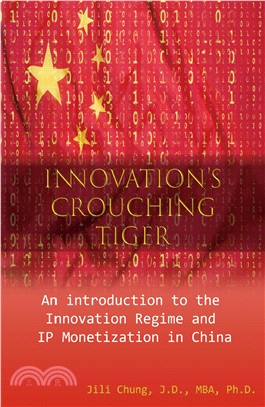Innovation's Crouching Tiger: An Introduction to the Innovation Regime and IP Monetization in China
商品資訊
系列名:臺灣學人
ISBN13:9781625034571
出版社:漢世紀數位文化EHGBooks
作者:Jili Chung(鐘基立)
出版日:2018/08/01
裝訂/頁數:平裝/110頁
規格:22.9cm*15.2cm*0.6cm (高/寬/厚)
版次:1
定價
:NT$ 600 元優惠價
:79 折 474 元
無庫存,下單後進貨(採購期約4~10個工作天)
下單可得紅利積點:14 點
商品簡介
作者簡介
目次
相關商品
商品簡介
面對中國在技術與創新領域的崛起,你可以選擇合作,你可以選擇競爭,但你不能作壁上觀。本書通過三個面向,解析中國創新環境的現狀與發展,並為企業如何最大利用智慧財產權的競爭優勢,提供有效可行的策略建議。
本書特別適合以下讀者
‧ 在中國投資的外商,特別是與文創或高科技產業相關的經營者
‧ 協助客戶在中國展業的律師、會計師及顧問
‧ 跟進中國智慧財產權制度發展現狀的觀察家或評論員
‧ 帶領企業與中國公司競爭的國際經理人
You may choose to collaborate, or to compete, but you cannot afford to wait and see! In facing China’s increasing influence on technology and innovation, this book unveils China’s innovative ecosystem through three crucial perspectives and concludes with effective strategies for maximizing your IP advantage.
Readers who will benefit most from this book are:
‧ Foreign investors in China, especially those in creative or high-tech industries;
‧ Legal, accounting or consulting professionals advising on doing business in China;
‧ Observers or commentators following the development of China’s IP regime; and
‧ Managers of global organizations competing with Chinese opponents on the innovative front.
Praise for
Innovation’s Crouching Tiger
Commercial law, like so much else in contemporary China, has in recent years been evolving at a pace foreseen by few observers. In this concise book, Jili Chung brings the reader up to date on important developments in intellectual property law in China – developments with special relevance to high-tech companies. With his training as an attorney and his broad experience in China, he brings an expert’s touch to the topic that few can match.
― John Akula, MIT Sloan School Senior Lecturer in Law
China has the potential to become the largest IP market in the world. Jili Chung offers indispensable perspectives on China's historical and cultural traditions for understanding this growing market.
― Wu Zhipan, former Executive Vice President of Peking University
Bravo! Dr. Jili Chung does an excellent job tackling a complex topic and presents a unique 360-degree perspective as an engineer, IP lawyer, tech business executive and lover of Chinese cultural values. Dr. Chung's work on China’s growing IP business and legal regime is relevant, timely and important ― a must read for entrepreneurs wishing to optimize, and competitors working with, China’s innovation ambitions.
― Grace Parke Fremlin, corporate attorney-at-law in Asian M&A, FDI, IP, and a partner at multiple global AMLAW 100 law firms advising companies on their investment efforts for global competitiveness.
Innovation and IP have become fundamental to succeeding in any business opportunity in China. The country’s speed, creativity and the variation with which it handles innovation and IP make it challenging to manage. Bringing decades of experience in China to the subject, Jili walks the reader through in-depth analysis, insiders’ insights, and case studies with ease, sharing his practical experience and valuable tips for managing these issues. Even more crucially, Jili reveals hidden recipes for leveraging different types of IP rights, enabling investors, entrepreneurs, and innovators to realize and maximize the value of their IP. Jili navigates this complex new world, sailing smoothly through issues of technology, knowledge, leverage and financing. The crouching tiger is in its prime time and ready to act. With this book, so are you.
― Ming-Tao Yang, a partner of Finnegan, Henderson, Farabow, Garrett & Dunner, LLP
本書特別適合以下讀者
‧ 在中國投資的外商,特別是與文創或高科技產業相關的經營者
‧ 協助客戶在中國展業的律師、會計師及顧問
‧ 跟進中國智慧財產權制度發展現狀的觀察家或評論員
‧ 帶領企業與中國公司競爭的國際經理人
You may choose to collaborate, or to compete, but you cannot afford to wait and see! In facing China’s increasing influence on technology and innovation, this book unveils China’s innovative ecosystem through three crucial perspectives and concludes with effective strategies for maximizing your IP advantage.
Readers who will benefit most from this book are:
‧ Foreign investors in China, especially those in creative or high-tech industries;
‧ Legal, accounting or consulting professionals advising on doing business in China;
‧ Observers or commentators following the development of China’s IP regime; and
‧ Managers of global organizations competing with Chinese opponents on the innovative front.
Praise for
Innovation’s Crouching Tiger
Commercial law, like so much else in contemporary China, has in recent years been evolving at a pace foreseen by few observers. In this concise book, Jili Chung brings the reader up to date on important developments in intellectual property law in China – developments with special relevance to high-tech companies. With his training as an attorney and his broad experience in China, he brings an expert’s touch to the topic that few can match.
― John Akula, MIT Sloan School Senior Lecturer in Law
China has the potential to become the largest IP market in the world. Jili Chung offers indispensable perspectives on China's historical and cultural traditions for understanding this growing market.
― Wu Zhipan, former Executive Vice President of Peking University
Bravo! Dr. Jili Chung does an excellent job tackling a complex topic and presents a unique 360-degree perspective as an engineer, IP lawyer, tech business executive and lover of Chinese cultural values. Dr. Chung's work on China’s growing IP business and legal regime is relevant, timely and important ― a must read for entrepreneurs wishing to optimize, and competitors working with, China’s innovation ambitions.
― Grace Parke Fremlin, corporate attorney-at-law in Asian M&A, FDI, IP, and a partner at multiple global AMLAW 100 law firms advising companies on their investment efforts for global competitiveness.
Innovation and IP have become fundamental to succeeding in any business opportunity in China. The country’s speed, creativity and the variation with which it handles innovation and IP make it challenging to manage. Bringing decades of experience in China to the subject, Jili walks the reader through in-depth analysis, insiders’ insights, and case studies with ease, sharing his practical experience and valuable tips for managing these issues. Even more crucially, Jili reveals hidden recipes for leveraging different types of IP rights, enabling investors, entrepreneurs, and innovators to realize and maximize the value of their IP. Jili navigates this complex new world, sailing smoothly through issues of technology, knowledge, leverage and financing. The crouching tiger is in its prime time and ready to act. With this book, so are you.
― Ming-Tao Yang, a partner of Finnegan, Henderson, Farabow, Garrett & Dunner, LLP
作者簡介
鐘基立博士是美國麻省理工學院斯隆學者,取得加州大學洛杉磯分校法律博士,北京大學法學博士,臺灣大學企管碩士、化學工程學士,以及麻省理工學院科技管理碩士。他為美國加州律師,並通過中國律師、專利代理人以及證券營業人員資格考試。
鐘博士在大中國區有20年的工作經驗,致力於智慧財產權策略的實踐,並對借由技術創新與知識產運營挖掘傳統文化價值的商業模式,具有高度熱忱。
鐘博士曾在華盛頓特區,香港,北京,上海,及臺北等城市的跨國大型專業機構工作,曾任高盛集團執行董事,高偉紳師事務所資深律師,以及蘋果供應鏈中創新型企業的法務長。 他現任廈門大學智慧財產權研究院兼職碩導以及技術授權主管總會中華臺北分會理事。
他著有“文創與高新產業融資”一書(北京大學出版社2015年出版)以及IP Monetization in China (2016 EHG Books Press)。
他的聯繫方式是:jili@sloan.mit.edu
Dr. Jili Chung is an MIT Sloan Fellow and holds a J.D. from UCLA, a Ph.D. from Peking University, an MBA and BS from National Taiwan University, and an MS in Management of Technology from MIT, with qualifications of attorney-at-law (California and China), a patent agent (China), and a Certification of Securities Professional (China).
With 20 years’ working experience in Greater China, he dedicates himself to IP-leveraged innovation and is enthusiastic about exploring values of ancient Chinese cultural heritage through IP mining and technology innovation.
Dr. Chung has worked in Washington D.C., Hong Kong, Beijing, Shanghai, and Taipei for global corporations, including as an executive director at Goldman Sachs, a senior lawyer at Clifford Chance, and as the General Counsel for a leading company in Apple’s supply chain. He is an adjunct professor of the Xiamen University Institute of Intellectual Property Rights in China, and a director of Licensing Executives Society Chinese Taipei.
He is the author of IP Financing for Creative and High-Tech Industries (2015 Peking University Press) and IP Monetization in China (2016 EHG Books Press).
He can be reached at jili@sloan.mit.edu
鐘博士在大中國區有20年的工作經驗,致力於智慧財產權策略的實踐,並對借由技術創新與知識產運營挖掘傳統文化價值的商業模式,具有高度熱忱。
鐘博士曾在華盛頓特區,香港,北京,上海,及臺北等城市的跨國大型專業機構工作,曾任高盛集團執行董事,高偉紳師事務所資深律師,以及蘋果供應鏈中創新型企業的法務長。 他現任廈門大學智慧財產權研究院兼職碩導以及技術授權主管總會中華臺北分會理事。
他著有“文創與高新產業融資”一書(北京大學出版社2015年出版)以及IP Monetization in China (2016 EHG Books Press)。
他的聯繫方式是:jili@sloan.mit.edu
Dr. Jili Chung is an MIT Sloan Fellow and holds a J.D. from UCLA, a Ph.D. from Peking University, an MBA and BS from National Taiwan University, and an MS in Management of Technology from MIT, with qualifications of attorney-at-law (California and China), a patent agent (China), and a Certification of Securities Professional (China).
With 20 years’ working experience in Greater China, he dedicates himself to IP-leveraged innovation and is enthusiastic about exploring values of ancient Chinese cultural heritage through IP mining and technology innovation.
Dr. Chung has worked in Washington D.C., Hong Kong, Beijing, Shanghai, and Taipei for global corporations, including as an executive director at Goldman Sachs, a senior lawyer at Clifford Chance, and as the General Counsel for a leading company in Apple’s supply chain. He is an adjunct professor of the Xiamen University Institute of Intellectual Property Rights in China, and a director of Licensing Executives Society Chinese Taipei.
He is the author of IP Financing for Creative and High-Tech Industries (2015 Peking University Press) and IP Monetization in China (2016 EHG Books Press).
He can be reached at jili@sloan.mit.edu
目次
Part I
Observations
Chapter 1 IP Monetization in China: An Overview 3
1.1. The formation of sizable IP pools 3
1.2. IP pledge 5
1.3. Experiments in novel IP financing 7
1.3.1. The IP pledges 7
1.3.2. The monetization of future IP – A case from 2008 7
1.3.3. IP monetization by crowdfunding: A case from 2015 8
Chapter 2 Observations From Behind the Scenes 13
2.1. The Planned Economy and Regulatory Regimes 13
2.1.1. The color of China’s planned economy 13
2.1.2. The National IP Strategy Outline 14
2.1.3. Regulatory framework 15
2.1.4. A national campaign promoting innovation 16
2.2. The Spirit of Experimentation 18
2.2.1. A speech during Deng Xiaoping's South China Tour in 1992 18
2.2.2. A spirit inherited 19
2.3. From Quantity to Quality 20
2.3.1. The IP pledge transaction 20
2.3.2. A driver of quantitative change 20
2.3.3. The strong demand for content IP by cultural and creative industries 23
2.4. Excess Liquidity in Certain Industry Sectors 25
Part II
An Analysis with Three Lenses
Chapter 3 The First Lens: IP Creation and Transfer - IP In-kind Contribution 28
3.1. Overview of the in-kind contribution 28
3.1.1. The meanings of innovation and IP monetization 28
3.1.2. A potential model in China 29
3.2. Obstacles and Challenges 32
3.2.1. The Increased Burden of Tax Compliance 32
3.2.2. Special Rules for FIEs 33
3.2.3. CSRC Retrospective Review 35
3.3. Trend and Insights 35
3.3.1. Observations from the policy announcement and regulatory actions 35
3.3.2. The rules continue to move in favor of IP monetization 36
3.3.3. Implementation rules vary by location 37
3.3.4. Enhanced scrutiny on the publicly-listed companies 37
Chapter 4 The First Lens: IP Creation and Transfer – Securitization 38
4.1. Overview of the practice 38
4.1.1. Copyright pooling and stockpiling 38
4.1.2. Creating IP-Derived rights 39
4.1.3. IP creation on the Internet 40
4.1.4. The current securitization platform - Crowdfunding and Quasi IP 41
4.1.5. The crowdfunding platform 44
4.2. Obstacles and Challenges 45
4.2.1. Regulatory Redlines 45
4.2.2. The IP exchange platform 46
4.3. Trends and Insights 47
4.3.1. Clear policies of encouragement 47
4.3.2. The government perspective on quasi-securitization 47
4.3.3. An attitude toward creative monetization 48
4.3.4. The mobile Internet trend 49
Chapter 5 The Second Lens: IP Pledge 51
5.1. Overview of the Practice 51
5.1.1. The current frameworks 51
5.1.2. Highlights of Development 54
5.1.3. Achievements 57
5.1.4. The variety of models 59
5.2. Obstacles and Challenges 61
5.2.1. Fading rosy pictures 61
5.2.2. How to utilize the patent pledge platforms 64
5.3. Trends and Insights 66
5.3.1. The precursor to credit asset securitization 66
5.3.2. Government’s strong commitment in building up the IP monetization regime 66
5.3.3. New media receptivity and the response to criticisms 67
5.3.4. Mutually reinforcing innovation regimes 68
Chapter 6 The Third Lens: IP Risk Mitigation 69
6.1. Overview of the Practice 69
6.1.1. The function of IP insurance 69
6.1.2. Insurance policies available in China 71
6.2. Obstacles and Challenges 76
6.3. Trend and Insights 78
6.3.1. Reinforcing Regimes 78
6.3.2. Emergence of the insurance conglomerate 79
6.3.3. Indicators of the development stages of innovative industries 79
6.3.4. The development of IP insurance is raising awareness about IP protection 81
Part III
Strategy Guidelines
Chapter 7 Eight Key Points for Success 84
7.1. Get Familiar with the Rules of the Game 84
7.2. Develop Win-Win Strategies 85
7.3. Occupy the High Ground with an Edge in IP 86
7.4. Utilize Effective Perspectives in Observing Developments 86
7.5. View the Development of Patent Insurance as an Indicator 87
7.6. Create a Detailed Contractual Agreement for In-Kind Investment 87
7.7. Collaborate with Research Institutes 88
7.8. Attend to Issues Involving FIEs 88
Chapter 8 Conclusion: Never Be Defeated 89
Observations
Chapter 1 IP Monetization in China: An Overview 3
1.1. The formation of sizable IP pools 3
1.2. IP pledge 5
1.3. Experiments in novel IP financing 7
1.3.1. The IP pledges 7
1.3.2. The monetization of future IP – A case from 2008 7
1.3.3. IP monetization by crowdfunding: A case from 2015 8
Chapter 2 Observations From Behind the Scenes 13
2.1. The Planned Economy and Regulatory Regimes 13
2.1.1. The color of China’s planned economy 13
2.1.2. The National IP Strategy Outline 14
2.1.3. Regulatory framework 15
2.1.4. A national campaign promoting innovation 16
2.2. The Spirit of Experimentation 18
2.2.1. A speech during Deng Xiaoping's South China Tour in 1992 18
2.2.2. A spirit inherited 19
2.3. From Quantity to Quality 20
2.3.1. The IP pledge transaction 20
2.3.2. A driver of quantitative change 20
2.3.3. The strong demand for content IP by cultural and creative industries 23
2.4. Excess Liquidity in Certain Industry Sectors 25
Part II
An Analysis with Three Lenses
Chapter 3 The First Lens: IP Creation and Transfer - IP In-kind Contribution 28
3.1. Overview of the in-kind contribution 28
3.1.1. The meanings of innovation and IP monetization 28
3.1.2. A potential model in China 29
3.2. Obstacles and Challenges 32
3.2.1. The Increased Burden of Tax Compliance 32
3.2.2. Special Rules for FIEs 33
3.2.3. CSRC Retrospective Review 35
3.3. Trend and Insights 35
3.3.1. Observations from the policy announcement and regulatory actions 35
3.3.2. The rules continue to move in favor of IP monetization 36
3.3.3. Implementation rules vary by location 37
3.3.4. Enhanced scrutiny on the publicly-listed companies 37
Chapter 4 The First Lens: IP Creation and Transfer – Securitization 38
4.1. Overview of the practice 38
4.1.1. Copyright pooling and stockpiling 38
4.1.2. Creating IP-Derived rights 39
4.1.3. IP creation on the Internet 40
4.1.4. The current securitization platform - Crowdfunding and Quasi IP 41
4.1.5. The crowdfunding platform 44
4.2. Obstacles and Challenges 45
4.2.1. Regulatory Redlines 45
4.2.2. The IP exchange platform 46
4.3. Trends and Insights 47
4.3.1. Clear policies of encouragement 47
4.3.2. The government perspective on quasi-securitization 47
4.3.3. An attitude toward creative monetization 48
4.3.4. The mobile Internet trend 49
Chapter 5 The Second Lens: IP Pledge 51
5.1. Overview of the Practice 51
5.1.1. The current frameworks 51
5.1.2. Highlights of Development 54
5.1.3. Achievements 57
5.1.4. The variety of models 59
5.2. Obstacles and Challenges 61
5.2.1. Fading rosy pictures 61
5.2.2. How to utilize the patent pledge platforms 64
5.3. Trends and Insights 66
5.3.1. The precursor to credit asset securitization 66
5.3.2. Government’s strong commitment in building up the IP monetization regime 66
5.3.3. New media receptivity and the response to criticisms 67
5.3.4. Mutually reinforcing innovation regimes 68
Chapter 6 The Third Lens: IP Risk Mitigation 69
6.1. Overview of the Practice 69
6.1.1. The function of IP insurance 69
6.1.2. Insurance policies available in China 71
6.2. Obstacles and Challenges 76
6.3. Trend and Insights 78
6.3.1. Reinforcing Regimes 78
6.3.2. Emergence of the insurance conglomerate 79
6.3.3. Indicators of the development stages of innovative industries 79
6.3.4. The development of IP insurance is raising awareness about IP protection 81
Part III
Strategy Guidelines
Chapter 7 Eight Key Points for Success 84
7.1. Get Familiar with the Rules of the Game 84
7.2. Develop Win-Win Strategies 85
7.3. Occupy the High Ground with an Edge in IP 86
7.4. Utilize Effective Perspectives in Observing Developments 86
7.5. View the Development of Patent Insurance as an Indicator 87
7.6. Create a Detailed Contractual Agreement for In-Kind Investment 87
7.7. Collaborate with Research Institutes 88
7.8. Attend to Issues Involving FIEs 88
Chapter 8 Conclusion: Never Be Defeated 89
主題書展
更多
主題書展
更多書展今日66折
您曾經瀏覽過的商品
購物須知
為了保護您的權益,「三民網路書店」提供會員七日商品鑑賞期(收到商品為起始日)。
若要辦理退貨,請在商品鑑賞期內寄回,且商品必須是全新狀態與完整包裝(商品、附件、發票、隨貨贈品等)否則恕不接受退貨。





































































![Wicked [Movie Tie-In]:魔法壞女巫電影原著](https://cdnec.sanmin.com.tw/product_images/006/006285284.jpg)
